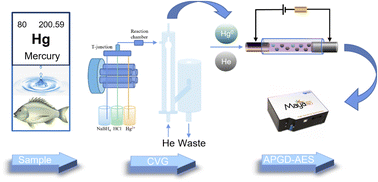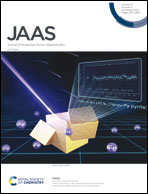Ultra-sensitive determination of mercury by atmospheric pressure glow discharge atomic emission spectrometry coupled with cold vapor generation
Abstract
In this work, a highly sensitive method for the determination of mercury was developed, based on direct-current atmospheric pressure glow discharge in helium (He) atomic emission spectroscopy (APGD-AES) coupled with cold vapor generation (CVG). The mercury vapor generated by CVG was transmitted to APGD through capillary for excitation, and the signal was recorded by a micro-spectrometer. The parameters of CVG and APGD systems were optimized, including NaBH4 concentration, hydrochloric acid concentration, He flow rate, discharge current and discharge gap. Under the optimum operating conditions, the detection limit (DL) of Hg was 0.26 μg L−1, and the relative standard deviation (RSD) was 0.7% (n = 11, 50 μg L−1). In the concentration range of 4–100 μg L−1, the linear correlation coefficient was better than 0.999. The accuracy and practicality of CVG-APGD-AES were verified by the analysis of the GBW10029 (fish) certified reference material (CRM) and human hair samples. The results were consistent with those of a direct mercury analysis (DMA) system and the certified value (relative deviation was less than 3%).

- This article is part of the themed collection: JAAS HOT Articles 2022


 Please wait while we load your content...
Please wait while we load your content...